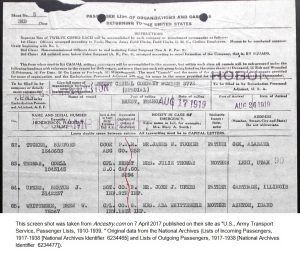“U.S., Army Transport Service, Passenger Lists, 1910-1939” has been on Ancestry.com for a while, but after seeing some fellow researchers post images I decided to revisit the database.
Some of the lists contain the name of the person that is to be notified in an emergency along with an address. Other lists contain the name of the soldier and his numerical designation. How helpful that information is really depends upon what is known about the soldier. In the case of Bertus Ufkes, the name of the father and address were already known. This database could be a place to locate additional details on the soldier’s unit that may help in locating additional documentation regarding his service
I knew that Bertus’ father was living at the time of World War I, but if I had not then this would have been helpful.
This database apparently can be searched by name of emergency contact if those words are put in the keyword box.
We’ll have a future post with a few additional suggestions for using this database and a neat discovery I made as well.


13 Responses
Thanks very much for your prompt to revisit this database. I just discovered that my husband’s grandfather was shipped out on the Baltic — the same steamship that brought him to the US as an immigrant in 1910. (He naturalized later, with a “one-paper natz” — the expedited process for service members who had served in WWI.)
Both outbound and inbound lists are in this collection, so your readers should be aware that their service members can be in the database more than once.
Thanks for your comments.
That’s a good point. The individuals I had a personal interest in where all listed at least twice.
I hope most of your readers will know this already, but the standard advice applies — don’t just rely on Ancestry’s details on their “record page” — dig down to the original images, and watch out for mistakes in Ancestry’s indexing. E.g. the ship Maui departed from Bordeaux in December of 1918 — and Ancestry’s index gives the date of arrival in New Jersey as December 1919! No, I don’t think it would take a steamship an entire year to get back to the USA. Browsing back to the pages that have the headers filled out will reveal the arrival date.
Thanks again for the tip!
See https://www.loc.gov/resource/20001931/1919-01-31/ed-1/?sp=8&st=text for explanation. Still looking for classifications.
Thank you. I have some ephemera from my grandfather’s return voyage from France in 1919, but I had no information on his trip TO France in July 1918….now I do 🙂
Thank you for this information. I was able to prove one family story and disprove another (second relative was a corporal, not a first lieutenant, but still a hero to me!). I didn’t know about this database so I appreciate that you took the time to point it out to us.
Thank you for showing this database! I had not run across it before! I knew my grandfather had served in the Marines before WWI in San Diego & Hawaii & have letters from him to my grandmother during WWI, but had no idea where he served during WWI. There he was, 2 entries leaving from Brooklyn,NY on the Briton in July, 1918 & returning from Brest, France to Hoboken, NJ in Jan 1919!
Any idea what ‘St Aignan Casual Company’ means?
A casual company was an army group specially composed for specific duties, drawing personnel from other types of units. They could be for things like driving ambulances or ammunition trucks, as my grandfather did in the Saint-Aignan Casual Company No. 4909. He volunteered for this dangerous duty to get out of the trenches as a regular infantry soldier, although the death rate for ammo truck drivers was higher than anything else. The name was taken from the town of Saint-Aignan where the American army was centered toward the close of the war and where a lot of organizational changes occurred.
There are several “Saint-Aignan” towns in France. Do you think this Saint Aignan is the one located approx. 20 miles east of Tours, in the Loire Valley? My Grandfather returned home from France with the Saint Aignan Casual Company No. 5981. I will be visiting France in May 2019 and wonder if this is the town/village from where these soldiers departed. if so, I would like to visit it.
Is there a list by the Company No. of each Casual Company as they debarked from NY ? Would that give further info on their Army unit’s specific duties before arrival at Saint-Aignan? I noticed my father had listed under “Notes” Saint-Aignan Casual Co. # 3978 – Special Discharge. What was a “special discharge”?
There is an article on these casual companies in a 1919 issue of the Army’s Stars and Stripes newspaper. I found it at https://www.loc.gov/resource/20001931/1919-01-31/ed-1/?sp=8&st=text&r=-0.183,-0.07,1.366,1.409,0
If that URL does not connect properly, go to https://sites.google.com/view/645thaerosquadron/home and scroll down to the name of GRIFFEN. Click on the last name to go to his detail page. At the end of his personal details page, I have transcribed the article.
I know from past research that my grandfather’s brother was killed in France in 1818, received the Distinguished Service Cross (posthumously), and was later shipped back to the U.S. for burial at Arlington. I had no information on the transports until these documents. The report shown does not indicate whether the person was living or deceased when returning.
I found my grandfather’s brother through Ancestry. My aunt told me that two of his brothers went off to war and did not return to Virginia.
St. Aignan Casual Company Nos.449 Colored.